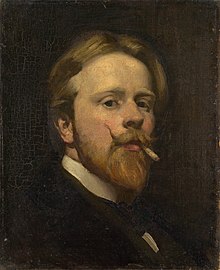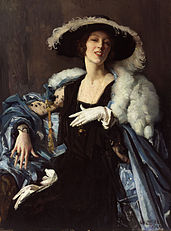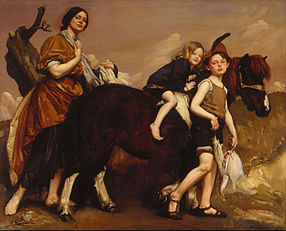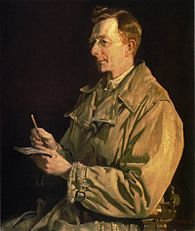George Washington Lambert
George Washington Lambert | |
|---|---|
 George Washington Lambert, c.1925, by Harold Cazneaux | |
| Born | George Washington Lambert 13 September 1873 Saint Petersburg, Russian Empire |
| Died | 29 May 1930 (aged 56) |
| Nationality | Australian |
| Education | Julian Ashton Art School |
| Known for | painting, drawing, sculpture |
| Notable work | Across the Black Soil Plains (1899) Anzac, the Landing 1915 (1922) The Squatter's Daughter (1924) Mrs Annie Murdoch (1927) |
| Children | Maurice Lambert, Constant Lambert |
George Washington Thomas Lambert
Early life
Lambert was born in
Career

Lambert began exhibiting his pictures at the Art Society and the Society of Artists, Sydney in 1894. Lambert began contributing pen-and-ink cartoons for The Bulletin in 1895 and began painting full-time in 1896.[1] Illustrations by Lambert formed part of the bush ballads of the Fair girls and gray horses (1898) and Hearts of gold (1903) anthologies of Scottish-Australian poet Will H. Ogilvie (1869–1963).
In 1899 he won the
War artist

Lambert became an official Australian war artist in 1917 during the First World War.
During the war years, George Lambert spent much time in London, where it is suggested he was romantically involved with fellow artist Thea Proctor.
Return to Australia
Lambert returned to Australia in 1921, where he had success in
In the second annual Archibald Prize in 1922, now Australia's most prestigious art prize for portraiture, Lambert's work was disqualified as he had not been a resident in Australia for twelve months.[4] He submitted a self-portrait for the third year, competing with William Macleod who entered with the subject of The Bulletin cartoonist 'Hop' Hopkins.[5] In 1927 he won the Archibald Prize with his work titled Mrs Murdoch.
In November 1927 he was commissioned to create a statue of writer Henry Lawson; the work depicting Lawson in rough clothes accompanied by a swagman, a dog and a fence post was unveiled in The Domain, Sydney on 28 July 1931 by the Governor of New South Wales, Sir Philip Game.[6]
Personal life
Lambert married Amelia Beatrice 'Amy' Absell (1872–1963) in 1900. Their children were
Lambert died on 29 May 1930 at Cobbitty, near Camden, New South Wales, and is buried in the Anglican section of South Head Cemetery.[1]
Some of his family papers from 1874 to 1942 are held in the State Library of New South Wales, Sydney.[7]
His life was dramatised in an episode of the radio series Famous Australians.
Gallery
-
Sergeant of the Light Horse
-
Portrait of the Artist's Family
-
Holiday in Essex
-
Portrait of a Lady
-
The Holiday Group (The Bathers)
-
Sybil Waller in a Red and Gold Dress
-
Miss Thea Proctor
-
The artist's wife, Amy, and their son Constant
See also
Notes
- ^ MUP. pp. 649–650. Retrieved 15 July 2009.
- ^ 'Camofleur', "Musketeers of Brush and Pencil with the A.I.F.: Art Under Fire: The Battlefield as Studio", The (Melbourne) Herald, (1 February 1919), p. 4.
- ^ "A sergeant of the Light Horse". George W Lambert Retrospective. National Gallery of Australia. Retrieved 4 May 2013.
- ^ "Archibald Prize". The Daily Telegraph. No. 13, 621. New South Wales, Australia. 6 January 1923. p. 5. Retrieved 24 February 2019 – via National Library of Australia.
- ^ "Gossip". Smith's Weekly. Vol. IV, no. 46. New South Wales, Australia. 6 January 1923. p. 17. Retrieved 24 February 2019 – via National Library of Australia.
- ^ "George W. Lambert retrospective". National Gallery of Australia. Retrieved 12 February 2014.
- ^ "George Lambert and Lambert family, papers and pictorial material, ca. 1874-1942". Catalogue. State Library of New South Wales. Retrieved 19 May 2020.
References
- Serle, Percival (1949). "Lambert, George Washington". Dictionary of Australian Biography. Sydney: Angus & Robertson. Retrieved 15 July 2009.
Further reading
- Grey, Anne (1996). George Lambert, 1873-1930 : art and artifice. Roseville East: Craftsman House. ISBN 9057040514.
- Grey, Anne (1996). George Lambert (1873-1930) catalogue raisonne : paintings and sculpture, drawings in public collection. Perth: Bonaray Press in association with Sotheby's and the Australian War Memorial. ISBN 0646301217.
External links
- 5 artworks by or after George Washington Lambert at the Art UK site
- Artist profile - Australian War Memorial
- Lambert exhibition, Gallipoli and Palestine landscapes - Australian War Memorial
- George Washington Lambert at Australian Art
- George Washington Lambert at Find a Grave
- Profile on Royal Academy of Arts Collections

















